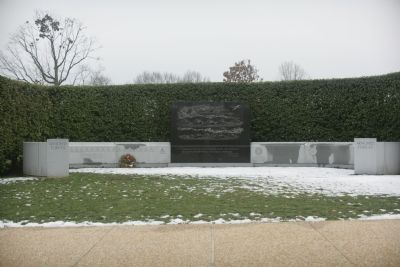Fort Myer in Arlington in Arlington County, Virginia — The American South (Mid-Atlantic)
Armored Forces
Maj Gen Adna Chaffee
Father of the American Armored Force
Topics and series. This memorial is listed in these topic lists: War, Korean • War, World I • War, World II. In addition, it is included in the National Cemeteries series list.
Location. 38° 52.976′ N, 77° 4.033′ W. Marker is in Arlington, Virginia, in Arlington County. It is in Fort Myer. Memorial is on Memorial Drive near Eisenhower Drive. Touch for map. Marker is in this post office area: Fort Myer VA 22211, United States of America. Touch for directions.
Other nearby markers. At least 8 other markers are within walking distance of this marker. 101st Airborne Division (within shouting distance of this marker); Women in Military Service for America Memorial (within shouting distance of this marker); "Price of Freedom" (about 300 feet away, measured in a direct line); The 23rd Regimental Combat Team in Korea (about 400 feet away); Richard Evelyn Byrd (about 500 feet away); World War II Killed in Action Memorial (about 500 feet away); Honoring the Women Who Served (about 600 feet away); Naval Combat Demolition Units (about 600 feet away). Touch for a list and map of all markers in Arlington.
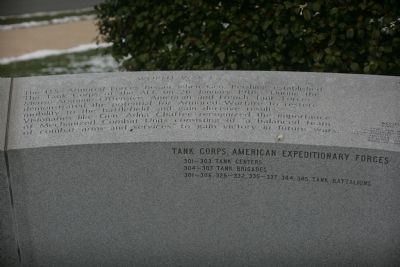
Photographed By Tom Fuchs, January 19, 2008
2. World War I
The U. S. Armored Forces began when Gen. Pershing established The Tank Corps of the AEF on 26 January 1918. During the Meuse Argonne Offensive, American and French Tank Forces demonstrated the potential for Armored Warfare to restore mobility to the battlefield and gain decisive results.
Visionaries like Gen. Adna Chaffee recognized the importance of Mechanized Combat Units consisting of "a balanced team of combat arms and services" to gain victory in future wars.
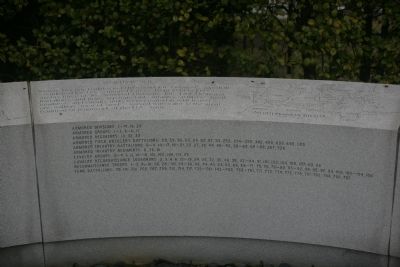
Photographed By Tom Fuchs, January 19, 2008
3. World War II
Visions became realities in 1940 when Gen George C. Marshall established the U. S. Armored Forces. From 1940 to 1945 a mighty force of 46 Armored Divisions, 106 Tank Destroyer Battalions and many separate tank, infantry, artillery, signal, engineer, and cavalry units were created in which over one million men of steel served with valor in the great tradition of teamwork of the U. S. Army.
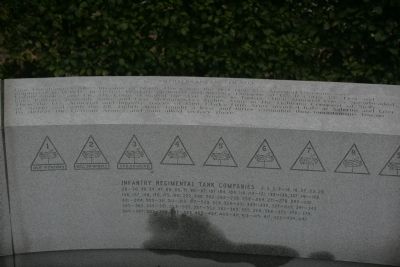
Photographed By Tom Fuchs, January 19, 2008
4. Mediterranean Theater
Gen Eisenhower's Allied Invasion of North Africa was the first time U. S. Armored Divisions were employed in WWII in Desert Warfare. Armored and Infantry Divisions of U. S. II Corps BR First and Eighth Armies and the I R XIX Corps defeated the Axis Armies in Tunisia. Then Armored Forces spearheaded Gen Patton's Seventh Army and Gen Montgomery's Eighth Army in the Lightning Conquest of Sicily. Then the U. S. Armored and Infantry forces of Gen Clark's Fifth Army invaded Italy at Salerno and later at Anzio and with the BR Eighth Army fought a long and bitter campaign thru mountainous terrain to defeat the German Armies and gain Allied victory there.
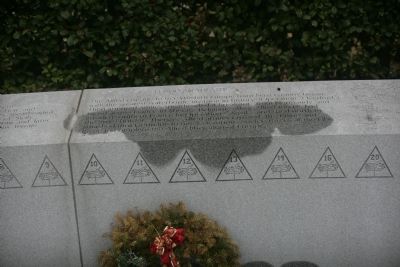
Photographed By Tom Fuchs, January 19, 2008
5. European Theater
The Allied crusade to free Western Europe from Nazi tyranny began with the greatest waterborne invasion in history ("Operation Overlord"). Then armored armies spearheaded a breakout from Normandy and raced across France to liberate Belgium. Also, Allied forces had invaded southern France in Operation Anvil and sped north to the Swiss border. The Allied armies crossed the Rhine and smashed thru Germany to meet victorious Soviet forces at the Elbe River to complete the Allied liberation of Europe.
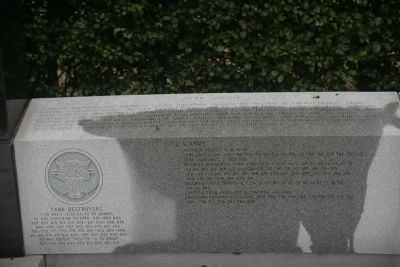
Photographed By Tom Fuchs, January 19, 2008
6. Pacific Theater
Armored, amphibian and amphibian tractor battalions stormed the beaches in Admiral Nimitz's island hopping campaign across the vast Central Pacific and by Admiral Halsey's conquest of the Solomons along with Gen MacArthur's campaign from New Guinea to the liberation of the Philippnes. In these campaigns, tank infantry teams expanded beachheads and led inland by a close assault of enemy fortified positions. Tarawa, Guadacanal, Buna, Saipan, Manila, Iwo Jima and Okinawa are but a few examples of the vicious close combat American solidiers and Marines and Australians experienced in defeating a fanatical enemy fighting to death from caves and bunkers.
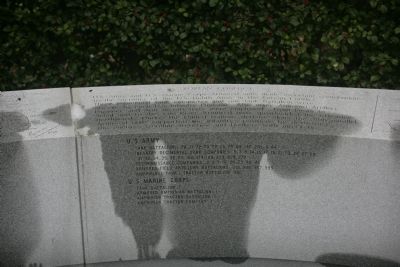
Photographed By Tom Fuchs, January 19, 2008
7. Korean Conflict
U. S. Army and U. S. Marine Corps Armored units made important contributions to the victories of the U. S. Eighth Army in the Korean Conflict. Three regimental tank companies and one tank battalion were organic to each U. S. Infantry Division. Also many Armored Artillery, Engineer, and Anti aircraft units were employed. From Pusan to Seoul and to the Yalu River, Armored units spearheaded the offensive northward. During the United States defense along the 38th parallel Armored units supported the Infantry's positions by destroying the enemy's frontline trenches and bunkers with direct fire.
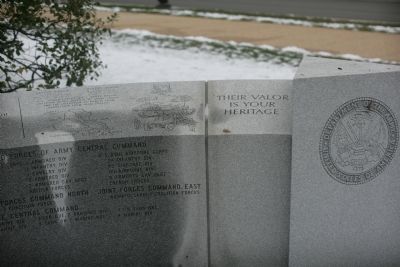
Photographed By Tom Fuchs, January 19, 2008
8. Their Valor Is Your Heritage
"Desert Shield"
Defense of the Kingdom of Saudi Arabia
2 Aug 1990 - 15 Jan 1991
"Desert Storm"
Liberation of the State of Kuwait
Jan - Feb, 1991
U. S. armed forces led a United Nations Coalition in the defense of Saudi Arabia and the liberation of Kuwait from agression from Iraqi forces.
Credits. This page was last revised on February 1, 2023. It was originally submitted on January 23, 2008, by Tom Fuchs of Greenbelt, Maryland. This page has been viewed 1,290 times since then and 39 times this year. Photos: 1, 2. submitted on January 23, 2008, by Tom Fuchs of Greenbelt, Maryland. 3, 4, 5, 6, 7, 8. submitted on January 24, 2008, by Tom Fuchs of Greenbelt, Maryland.
